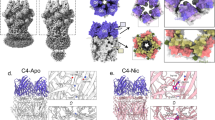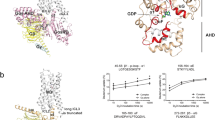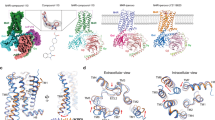Abstract
The α7 acetylcholine receptor (AChR) mediates pre- and postsynaptic neurotransmission in the central nervous system and is a potential therapeutic target in neurodegenerative, neuropsychiatric and inflammatory disorders. We determined the crystal structure of the extracellular domain of a receptor chimera constructed from the human α7 AChR and Lymnaea stagnalis acetylcholine binding protein (AChBP), which shares 64% sequence identity and 71% similarity with native α7. We also determined the structure with bound epibatidine, a potent AChR agonist. Comparison of the structures revealed molecular rearrangements and interactions that mediate agonist recognition and early steps in signal transduction in α7 AChRs. The structures further revealed a ring of negative charge within the central vestibule, poised to contribute to cation selectivity. Structure-guided mutational studies disclosed distinctive contributions to agonist recognition and signal transduction in α7 AChRs. The structures provide a realistic template for structure-aided drug design and for defining structure–function relationships of α7 AChRs.
This is a preview of subscription content, access via your institution
Access options
Subscribe to this journal
Receive 12 print issues and online access
$209.00 per year
only $17.42 per issue
Buy this article
- Purchase on Springer Link
- Instant access to full article PDF
Prices may be subject to local taxes which are calculated during checkout








Similar content being viewed by others
References
Brejc, K. et al. Crystal structure of an ACh-binding protein reveals the ligand-binding domain of nicotinic receptors. Nature 411, 269–276 (2001).
Celie, P.H. et al. Nicotine and carbamylcholine binding to nicotinic acetylcholine receptors as studied in AChBP crystal structures. Neuron 41, 907–914 (2004).
Hansen, S.B. et al. Structures of Aplysia AChBP complexes with nicotinic agonists and antagonists reveal distinctive binding interfaces and conformations. EMBO J. 24, 3635–3646 (2005).
Unwin, N. Refined structure of the nicotinic receptor at 4 Å resolution. J. Mol. Biol. 346, 967–989 (2005).
Dellisanti, C.D., Yao, Y., Stroud, J.C., Wang, Z.Z. & Chen, L. Crystal structure of the extracellular domain of nAChR α1 bound to alpha-bungarotoxin at 1.94 Å resolution. Nat. Neurosci. 10, 953–962 (2007).
Hilf, R.J. & Dutzler, R. X-ray structure of a prokaryotic pentameric ligand-gated ion channel. Nature 452, 375–379 (2008).
Hilf, R.J. & Dutzler, R. Structure of a potentially open state of a proton-activated pentameric ligand-gated ion channel. Nature 457, 115–118 (2009).
Bocquet, N. et al. X-ray structure of a pentameric ligand-gated ion channel in an apparently open conformation. Nature 457, 111–114 (2009).
Breese, C.R. et al. Comparison of regional expression of nicotinic acetylcholine receptor α7 mRNA and [125I]- α-bungarotoxin binding in human postmortem brain. J. Comp. Neurol. 387, 385–398 (1997).
Fabian-Fine, R. et al. Ultrastructural distribution of the α 7 nicotinic acetylcholine receptor subunit in rat hippocampus. J. Neurosci. 21, 7993–8003 (2001).
Seguéla, P., Wadiche, J., Dinely-Miller, K., Dani, J. & Patrick, J.W. Molecular cloning, functional properties, and distribution of rat brain alpha 7: a nicotinic cation channel highly permeable to calcium. J. Neurosci. 13, 596–604 (1993).
Alkondon, M., Pereira, E.F., Cortes, W.S., Maelicke, A. & Albuquerque, E.X. Choline is a selective agonist of alpha7 nicotinic acetylcholine receptors in the rat brain neurons. Eur. J. Neurosci. 9, 2734–2742 (1997).
Grosman, C. & Auerbach, A. Asymmetric and independent contribution of the second transmembrane segment 12' residues to diliganded gating of acetylcholine receptor single channels: a single channel study with choline as the agonist. J. Gen. Physiol. 115, 637–651 (2000).
Martin, L.F., Kem, W.R. & Freedman, R. Alpha-7 nicotinic receptor agonists: potential new candidates for the treatment of schizophrenia. Psychopharmacology 174, 54–64 (2004).
D'Andrea, M.R. & Nagele, R.G. Targeting the alpha-7 nicotinic acetylcholine receptor to reduce amyloid accumulation in Alzheimer's disease pyramidal neurons. Curr. Pharm. Des. 12, 677–684 (2006).
Wang, H. et al. Nicotinic acetylcholine receptor a7 subunit is an essential regulator of inflammation. Nature 421, 384–388 (2003).
Sine, S.M. The nicotinic receptor ligand binding domain. J. Neurobiol. 53, 431–446 (2002).
Zouridakis, M., Zisimopoulou, P., Eliopoulos, E., Poulas, K. & Tzartos, S.J. Design and expression of human alpha7 nicotinic acetylcholine receptor extracellular domain mutants with enhanced solubility and ligand-binding properties. Biochim. Biophys. Acta 1794, 355–366 (2009).
Mukhtasimova, N., Free, C. & Sine, S.M. Initial coupling of binding to gating mediated by conserved residues in muscle nicotinic receptor. J. Gen. Physiol. 126, 23–39 (2005).
Grosman, C., Zhou, M. & Auerbach, A. Mapping the conformational wave of acetylcholine receptor channel gating. Nature 403, 773–776 (2000).
Metrangolo, P., Neukirch, H., Pilati, T. & Resnati, G. Halogen bonding based recognition processes: A world parallel to hydrogen bonding. Acc. Chem. Res. 38, 386–395 (2005).
Bouzat, C. et al. Coupling of agonist binding to channel gating in an ACh-binding protein linked to an ion channel. Nature 430, 896–900 (2004).
Lee, W.Y. & Sine, S.M. Principal pathway coupling agonist binding to channel gating in the nicotinic receptor. Nature 438, 243–247 (2005).
Mukhtasimova, N. & Sine, S.M. An inter-subunit trigger of channel gating in the muscle nicotinic receptor. J. Neurosci. 27, 4110–4119 (2007).
Wang, H.L., Cheng, X., Taylor, P., McCammon, J.A. & Sine, S.M. Control of cation permeation through the nicotinic receptor channel. PLoS Comput. Biol. 4 e41, 1–9 (2008).
Hibbs, R.E. & Gouaux, E. Principles of activation and permeation in an anion-selective Cys-loop receptor. Nature 474, 54–60 (2011).
Smit, A.B. et al. A glia-derived acetylcholine-binding protein that modulates synaptic transmission. Nature 411, 261–268 (2001).
Jones, D.H. & Winistorfer, S.C. Recombinant circle PCR and recombination PCR for site-specific mutagenesis without PCR product purification. Biotechniques 12, 528–530 (1992).
Heckman, K.L. & Pease, L.R. Gene splicing and mutagenesis by PCR-driven overlap extension. Nat. Protoc. 2, 924–932 (2007).
Gao, F. et al. Curariform antagonists bind in different orientations to acetylcholine binding protein. J. Biol. Chem. 278, 23020–23026 (2003).
Gao, F. et al. Solution NMR of acetylcholine binding protein reveals agonist-mediated conformational change of the C-loop. Mol. Pharmacol. 70, 1230–1235 (2006).
Otwinowski, Z. & Minor, W. Processing of X-ray diffraction data collected in oscillation mode. Methods Enzymol. 276, 307–326 (1997).
Vagin, A. & Teplyakov, A. Molecular replacement with MOLREP. Acta Crystallogr. D Biol. Crystallogr. 66, 22–25 (2010).
Emsley, P. et al. Features and development of Coot. Acta Crystallogr. D Biol. Crystallogr. 66, 486–501 (2010).
Brünger, A.T. et al. Crystallography & NMR system: A new software suite for macromolecular structure determination. Acta Crystallogr. D Biol. Crystallogr. 54, 905–921 (1998).
Williams, M.E. et al. Ric-3 promotes functional expression of the nicotinic acetylcholine receptor alpha7 subunit in mammalian cells. J. Biol. Chem. 280, 1257–1263 (2005).
Bouzat, C., Bartos, M., Corradi, J. & Sine, S.M. Binding-pore interface of homomeric Cys-loop receptors governs open channel lifetime and rate of desensitization. J. Neurosci. 28, 7808–7819 (2008).
Sine, S.M., Quiram, P., Papanikolaou, F., Kreienkamp, H.J. & Taylor, P. Conserved tyrosines in the α subunit of the nicotinic acetylcholine receptor stabilize quaternary ammonium groups of agonists and curariform antagonists. J. Biol. Chem. 269, 8808–8816 (1994).
Acknowledgements
We thank Advanced Light Source Berkeley Center for Structural Biology staff members C. Ralston, P. Zwart, C. Bertoldo, A. Rozales and K. Royal for help with data collection, N. Chelyapov and University of Southern California NanoBiophysics Core Facility for help with multi-angle light scattering analyses and P. Taylor for providing cDNA encoding AChBP. This work is supported by US National Institutes of Health grants NS031744 to S.M.S. and HL076334 and GM064642 to L.C.
Author information
Authors and Affiliations
Contributions
S.M.S. and L.C. supervised the project; S.H., N.B. and S.M.S. designed and built the α7–AChBP chimera; N.B. and S.H. expressed the protein; S.H., N.B. and S.-X.L. purified the protein; S.-X.L., S.H., C.D.D., K.N. and L.C. grew the crystals; S.-X.L. and L.C. collected diffraction data, solved and refined the structure; S.M.S. and N.B. conducted the radioligand binding experiments; and S.M.S., L.C., S.L. and S.H. wrote the paper.
Corresponding authors
Ethics declarations
Competing interests
The authors declare no competing financial interests.
Supplementary information
Supplementary Text and Figures
Supplementary Figures 1–11, Supplementary Tables 1 and 2 (PDF 1296 kb)
Rights and permissions
About this article
Cite this article
Li, SX., Huang, S., Bren, N. et al. Ligand-binding domain of an α7-nicotinic receptor chimera and its complex with agonist. Nat Neurosci 14, 1253–1259 (2011). https://doi.org/10.1038/nn.2908
Received:
Accepted:
Published:
Issue Date:
DOI: https://doi.org/10.1038/nn.2908
This article is cited by
-
Exploration of the mechanism by which Huangqi Guizhi Wuwu decoction inhibits Lps-induced inflammation by regulating macrophage polarization based on network pharmacology
BMC Complementary Medicine and Therapies (2023)
-
Membrane-mediated interaction of non-conventional snake three-finger toxins with nicotinic acetylcholine receptors
Communications Biology (2022)
-
α7 nicotinic acetylcholine receptor upregulation by anti-apoptotic Bcl-2 proteins
Nature Communications (2019)
-
α7nAChR Deletion Aggravates Myocardial Infarction and Enhances Systemic Inflammatory Reaction via mTOR-Signaling-Related Autophagy
Inflammation (2019)
-
(E)-Nicotinaldehyde O-Cinnamyloxime, a Nicotine Analog, Attenuates Neuronal Cells Death Against Rotenone-Induced Neurotoxicity
Molecular Neurobiology (2019)



